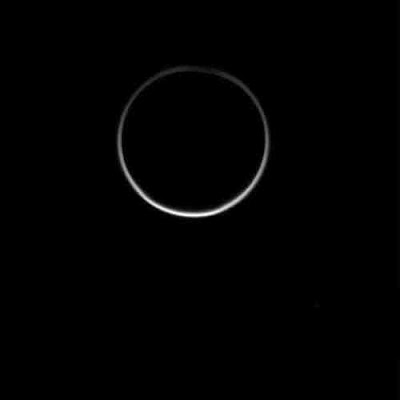The
Cassini Space Probe was launched on 15 October 1997 from
Cape Canaveral Air Force Station and entered orbit around Saturn on 30 June 2004. It has been sending back data on and images of the planet, its moons and its ring system ever since. This month it has produced a number of new images of three of Saturn's moons, Titan, Tethys and Methone.
Titan is the largest moon of Saturn, and the second largest in the Solar System (after Jupiter's moon Ganymede). It is the only moon in the Solar System with a dense atmosphere and has a volume 17% larger than that of Mercury. On 14 January 2005 the
Huygens Probe, which had been launched from Cassini, landed on the surface of Titan, beaming bake images of a world with lakes and rivers of hydrocarbons at the surface.
Image of Titan taken by Cassini on 21 May from a distance of 283 125 km, and received on Earth on 22 May. NASA/JPL/Space Science Institute.
Image of Titan taken by Cassini on 21 May from a distance of 253 205 km, and received on Earth on 22 May. NASA/JPL/Space Science Institute.
Image of Titan taken by Cassini on 22 May from a distance of 124 753 km, and received on Earth on 22 May. NASA/JPL/Space Science Institute.
Image of Titan taken by Cassini on 22 May from a distance of 153 964 km, and received on Earth on 22 May. NASA/JPL/Space Science Institute.
Image of Titan taken by Cassini on 22 May from a distance of 205 137 km, and received on Earth on 22 May. NASA/JPL/Space Science Institute.
Tethys is the 5th largest moon of Saturn and the 16th largest moon in the Solar System. This makes it the smallest large moon in the Solar System, having a greater mass than all the smaller moons combined. It has an icy, crater covered, surface and a low density, causing scientists to believe it is largely made of ice.
Image of Tethys taken by Cassini on 20 May from a distance of 53 810 km, and received on Earth on 21 May. NASA/JPL/Space Science Institute.
Image of Tethys taken by Cassini on 20 May from a distance of 53 968 km, and received on Earth on 21 May. NASA/JPL/Space Science Institute.
Image of Tethys taken by Cassini on 20 May from a distance of 54 203 km, and received on Earth on 21 May. NASA/JPL/Space Science Institute.
Image of Tethys taken by Cassini on 20 May from a distance of 54 613 km, and received on Earth on 21 May. NASA/JPL/Space Science Institute.
Image of Tethys taken by Cassini on 20 May from a distance of 54 758 km, and received on Earth on 21 May. NASA/JPL/Space Science Institute.
Image of Tethys taken by Cassini on 20 May from a distance of 54 997 km, and received on Earth on 21 May. NASA/JPL/Space Science Institute.
Image of Tethys taken by Cassini on 20 May from a distance of 55 458 km, and received on Earth on 21 May. NASA/JPL/Space Science Institute.
Image of Tethys taken by Cassini on 20 May from a distance of 57 981 km, and received on Earth on 21 May. NASA/JPL/Space Science Institute.
Image of Tethys taken by Cassini on 20 May from a distance of 61 730 km, and received on Earth on 21 May. NASA/JPL/Space Science Institute.
Image of Tethys taken by Cassini on 20 May from a distance of 61 849 km, and received on Earth on 21 May. NASA/JPL/Space Science Institute.
Image of Tethys taken by Cassini on 20 May from a distance of 93 995 km, and received on Earth on 21 May. NASA/JPL/Space Science Institute.
Image of Tethys taken by Cassini on 20 May from a distance of 127 872 km, and received on Earth on 21 May. NASA/JPL/Space Science Institute.
Image of Tethys taken by Cassini on 20 May from a distance of 53 808 km, and received on Earth on 21 May. NASA/JPL/Space Science Institute.
Methone is a minor moon of Saturn that was discovered by the Cassini Probe in 2004. It is smooth and egg-shaped, with an average radius of 1.6 km.
Image of Methone taken by Cassini on 20 May, and received on Earth on 21 May. NASA/JPL/Space Science Institute.























































